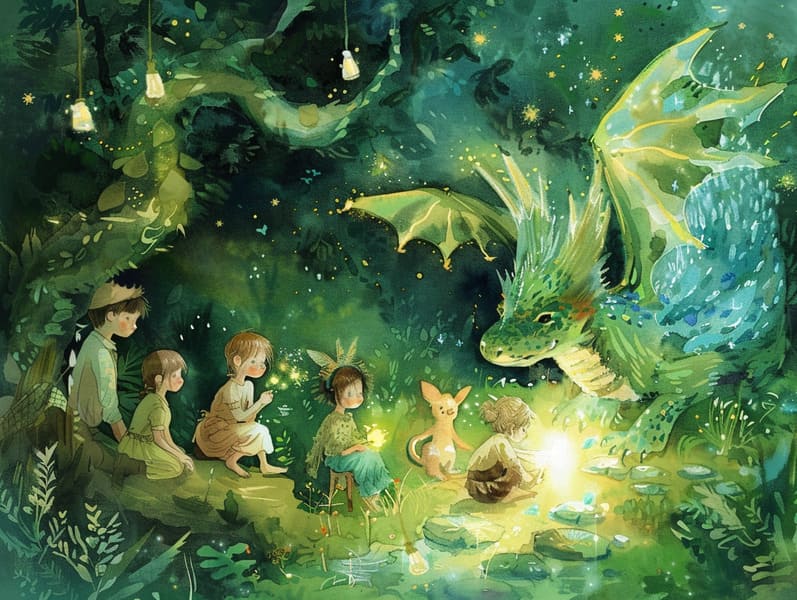Understanding the Legacy of Grimm's Fairy Tales with Its Everlasting Attraction.
Understanding the Legacy of Grimm's Fairy Tales with Its Everlasting Attraction.
Blog Article

Children's fairy tales have deep roots. These tales have been narrated from one generation to the next centuries before they were ever documented. They originated from a variety of backgrounds, including European traditions. They were initially narrated among elders, often carrying themes and messages aligned with the societal norms and beliefs of the time.
The Grimm brothers, Jacob and Wilhelm Grimm, were among the first to gather many of these beloved fairy tales. Their compilation, "Grimm's Fables," included tales like "Cinder Maid," "Hansel and Grethel," and "The True Story of Snow White," which have since become mainstays in the world of traditional fairy tales. Similarly, H. C. Andersen's enchanting tales, such as "The Mermaid's Tale," and "The Story of the Ugly Duckling," have won hearts worldwide, cementing their place in the pantheon of treasured fairy tales.
Though they are centuries old, classic fairy tales remain as important as ever, especially as kids' bedtime tales. These whimsical stories are now available in diverse formats, including gorgeously illustrated books, fantastical animations, and online storybooks.
Their ongoing significance can be traced to several magical reasons:
Key Lessons: Ancient fairy tales often offer important moral lessons. Stories like "The Story of the Boy Who Cried Wolf" teach the virtue of honesty, while "The Story of the Tortoise and the Hare" illustrate the qualities of tenacity and unpretentiousness. These narratives offer the young clear distinctions between right and wrong, molding their moral compass in a mild yet deep way.
Warmth and Understanding: Traditional fairy tales frequently illustrate heroes facing difficulties and adversities, encouraging kids to connect with their struggles and celebrate their triumphs. For instance, "The Story of Beauty and the Beast" shows us the importance of seeing beyond looks to recognize the real character of a person, developing tenderness and comprehension.
Cultural Recognition: Many traditional fairy tales are infused with the cultural contexts from which they arose. Reading these narratives can provide illuminating insights into different customs, building a sense of global insight and recognition.
Imagination and Innovation: The whimsical elements in fairy tales—supernatural elements—fire up children’s imaginations. These stories guide readers to imaginary realms, unleashing creative thinking and a sense of astonishment that lasts a lifetime.
Ancient fairy tales are not only fascinating but also teaching. They work as spellbinding tools in building various brain and heart skills in the young. When old fairy tales are voiced, they nurture verbal development by introducing new lexicon and complex sentence structures. This practice also nurtures auditory skills and attentiveness, as young readers keep up with the story, eager to see what happens next.
Furthermore, conversing about the themes and characters of traditional fairy tales can nurture critical thinking and analytical skills. Young readers are shown to discover patterns, foresee events, and understand cause and effect. These deliberations also advance young ones reveal their thoughts and feelings, boosting their emotional intelligence.
In today’s information age, the presence of digital storybooks has made these stories more within reach than ever. Digital sites and web apps offer wide arrays of ancient fairy tales that can be perused or played anytime, anywhere. Fairy tales told out loud are particularly prevalent, giving an entertaining method for kids to immerse in these magical stories. Narrated books and narrated videos lead characters and settings to life, often supplemented by charming audio effects and melodies that enhance the tale journey.
The timeless allure of classic fairy tales lies in their ability to evolve to contemporary times while sustaining their core messages. Contemporary reinterpretations of these fairy tales often present more diverse protagonists and modern settings, making them understandable to today’s audience. However, the main ideas of braveness, generosity, and honesty remain unchanged, continuing to reach young listeners of all ages.
Fairy tales also offer a sense of security and knowability. They showcase a methodical narrative with a clear beginning, middle, and end, often concluding with the resolution of conflicts and the triumph of truth over falsehood. This steadiness can be easing for young ones, distributing a sense of stability in an unstable world.
Ancient fairy tales continue to enchant and train new generations, maintaining their beauty and meaningfulness in modern society. As bedtime stories for kids, they confer upon a perfect blend of wonder and wisdom, backing moral values, empathy, and creativity. The availability of web-based fairy tales and the commonness of fairy tales voiced warrant that these timeless stories remain attainable to new generations.
By defending and making known these fairy tales, we continue to treasure the rich tapestry of fables and cultural heritage. Whether you are browsing a colorful picture book, seeing a internet collection, or listening via an audiobook, the majesty of famous fairy tales is always within reach. These fairy tales reveal of the endless power of tales and its ability to bind us across epochs and places.
No matter if you are seeing a richly illustrated book, delving into a web-based library, or listening to an audiobook, the radiance of popular fairy tales is always here within reach.
These fairy tales emphasize of the persistent power of fairy tales and its ability to tie us across time and space, forging a link that delights and instructs alike.